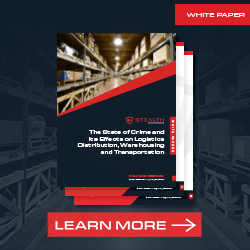The COVID-19 pandemic catalyzed a monumental digital shift across industries. With consumer behavior increasingly moving online, companies responded by rapidly digitizing business processes and models. However, as legitimate business embraces the digital landscape, criminals are finding new footing as well.
According to CargoNet’s Q3 2023 supply chain risk report, freight fraud is evolving alongside increased digitalization. The analysis uncovered concerning trends – CargoNet recorded nearly 700 fraud events in the US and Canada last quarter, representing a 60% year-over-year increase. As digital platforms create new opportunities for businesses and customers alike, they have also expanded the playing field for bad actors.
While digitization brings immense benefits, it also requires heightened vigilance. As the supply chain industry continues adopting advanced digital tools and strategies, securing these innovations remains a parallel priority.
The seriousness of the problem can’t be understated. Bad actors swiped more than $31 million in shipments during the third quarter of 2023. Reported thefts went up in all the event categories. Strategic freight fraud theft went up by 430% year-over-year. All signs indicate that this issue isn’t likely to go away.
“We also caution that strategic cargo theft groups continue to pioneer new methods of strategic cargo theft that seek to evade common compliance practices used by logistics brokers,” writes CargoNet in its news release. “Strategic cargo theft groups have shown keen interest in perpetrating fraud against small motor carriers or owner/operators with the intent of hijacking their accounts or convincing them to solicit shipments from logistics brokers on their behalf. Both strategies seek to evade identity theft, checks a logistics broker may do prior to tendering a shipment.”
The data reveals concerning geographic trends in freight theft during Q3 of 2023. Nearly half of reported incidents occurred in just three states—California, Texas, and Illinois. The same pattern holds for cargo theft, heavily concentrated in California, Texas, and Florida. However, no state is immune. Businesses across the country have seen an uptick in fraud.
Yet these figures likely underestimate the true scale of the issue. Experts warn that many freight crimes go unreported, whether due to concerns over insurance premium hikes, negative publicity, or other factors.
While the clustering of theft in transport hubs raises red flags, it should not breed complacency. As criminals grow more sophisticated in targeting supply chains’ digital vulnerabilities, ripple effects can radiate through networks regardless of location. Proactive collaboration between law enforcement, insurers, and freight companies will be integral to getting ahead of bad actors’ continuously adapting tactics. Education will also help the industry make progress by empowering personnel at all levels to identify and speak up against suspicious activities. With coordinated efforts, those in the industry can work to ensure that all geographic areas and supply chain stakeholders are protected against emerging fraud schemes.
Top Freight Fraud Tactics
In today’s interconnected world, phishing scams have become a ubiquitous threat – one that most email users have encountered firsthand. These attacks aim to manipulate targets into divulging passwords, financial data, and other sensitive information by impersonating trustworthy businesses. They exemplify social engineering, a tactic that exploits human psychology rather than technological vulnerabilities.
Unfortunately, the supply chain sector is not immune. Sophisticated freight fraud rings are now employing similar social engineering strategies to propagate schemes like fictitious pickups and pilferage. From identity theft to manipulating shipment tracking to falsified pickup orders, these attacks rely on deceiving human targets.
As digital platforms have successfully transformed supply chain coordination, they have also expanded the attack surface for organized crime. However, awareness represents our best defense.
Freight fraud through identity theft
Advances in technology have brought immense efficiency gains to the freight sector, but they have also expanded the arsenal for criminals. Artificial intelligence and digitized processes now enable sophisticated identity theft and social engineering schemes.
In fictitious pickup fraud, perpetrators impersonate legitimate companies by forging credentials and building convincing fake websites. Posing as brokers, shippers, or carriers, they negotiate freight contracts, establish trust through familiar branding and then disappear with loads. These scams often target rushed shipments, relying on tight deadlines to minimize vetting.
Criminals also leverage information gleaned through social engineering to reroute freight or add unauthorized stops – altering delivery while evading detection. As shippers and logistics providers digitize operations, securing data and identities is essential.
Some crime rings are resorting to violence if they cannot get what they want. Danny Ramon, intelligence and response manager at Overhaul, confirms this in a Transport Topics article.
Keith Lewis, vice president of operations at CargoNet told Transport Topics, “Instead of striking one load, they’re going after three or four loads at one time. They’re getting bolder; they’re getting more brazen. I wouldn’t say they’re getting desperate, but the value of these goods on the open market is driving up the risk of theft.”
Pilferages
Pilferage represents a particularly problematic threat in modern supply chains. Rather than overt cargo theft, these schemes discreetly siphon valuable goods from trailers, often targeting individual pallets or partial loads. With criminals realizing that full truck seizures invite greater scrutiny, pilferage has become an avenue of choice to quietly reap profits.
And the problem is intensifying. Where pilferage once comprised only 10% of a 53-ft trailer’s cargo, current estimates place that figure closer to 90% in some cases. Thieves capitalize on shipments in transit between destinations, counting on greater latitude to operate undetected. From a reporting perspective, ambiguous timelines make it challenging for drivers to pinpoint incidents and contact appropriate law enforcement.
In some cases, sophisticated rings combine pilferage with identity deception, impersonating legitimate carriers to manipulate records and conceal partial thefts. For instance, criminals may digitally alter bills of landing to show fewer pallets loaded after skimming quantities in transit. With paperwork validating reduced numbers upon delivery, discrepancies go unnoticed.
What can warehouses and distribution centers, facilities, and transportation do to prevent freight fraud through identity theft and pilferage?
Top Ways to Help Prevent Freight Fraud
While technology promises advances like streamlined coordination and visibility, realizing these benefits without compromise requires vigilance. Through security education, identity verification standards and resources for reporting suspicious activities, companies can empower employees to identify and speak up against social engineering red flags. Law enforcement and industry partnerships also help propagate actionable threat intelligence. Leveraging both human and technical safeguards will allow the freight sector to prevent fraud while still capturing digital efficiency gains.
To combat pilferage, companies often implement security measures such as enhanced surveillance, secure packaging, tamper-evident seals, and real-time tracking systems. These measures help in detecting and preventing the theft of individual items from the cargo.
Implementing layered security is a powerful approach that can help deter freight fraud. Remember, it’s a social engineering crime. People are involved. These top ways can help reduce the chances of social engineering from happening while adding layers that overlap.
Implement processes and procedures
Processes and procedures include items like contacting the carrier to check the bids on the shipment. In addition, contact customers and partners to verify the shipment. Look up the contact information on file with the Federal Motor Carrier Safety Administration (FMCSA) and confirm the driver and carrier identity match the shipment information.
Here’s why it’s crucial to educate drivers and logistics employees. They need to watch for anyone who attempts to pay with a peer-to-peer money transfer app. Another hint is the shipment address is different from the one on the bill of lading.
It also helps to require the carrier to provide information within 24 hours before pick-up. Get the name of the driver and the carrier, the truck number, and insurance information. If you don’t already, use a system to track shipments. This system may let you keep a list of approved truck drivers.
You may have processes in place, but it doesn’t mean that all employees follow them. Therefore, it’s important to do random spot checks and self-audits. Employees should also go through training on security protocols at least once a year. It should be standard operating procedure for all new employees and drivers to undergo background checks.
Make it a policy to not allow trailers to sit overnight filled with cargo. In fact, it’s better to wait to pack the trailer until right before its departure. Before releasing the load to the driver, take a photo of the driver, truck, and bill of lading.
Resourceful crime rings watch logistics facilities and distribution centers. They will follow a truck when it drives away with cargo. The plan is to pilfer the cargo when the truck stops for food, gas, or a break. Advise drivers to prepare to travel at least 200 miles before stopping.
Use smart locks, sensors, GPS trackers, and seals
Enhancing logistics security measures involves deploying a diverse range of technologies to create barriers. Using various sensors, GPS trackers, and smart locks can add an extra layer of protection. Fortunately, these technologies are becoming more cost-effective, compact, and challenging for perpetrators to detect.
Consider investing in advanced security features like air cuff locks and high-security rear door locks. These locks not only secure the dashboard brake valves but also prevent unauthorized movement of both the truck and the trailer, bolstering overall security.
To detect potential breaches, look into light sensors capable of reporting subtle changes in ambient lighting. They send an alert if someone has opened the truck doors. Temperature sensors are another valuable tool, monitoring shifts in temperature that could hint at cargo tampering. Some sensors even offer real-time alerts to dispatchers, enabling quick response and investigation.
Sophisticated criminals use 3D printers to replicate security devices. Fight back by randomizing the color of the seals. Regular vigilance is paramount. To ensure their integrity, drivers must inspect seals and locks each time they step away and return.
Add video surveillance with remote monitoring
As supply chains have digitized, remote video surveillance has emerged as an invaluable tool for proactive fraud and liability deterrents. Unlike reactive security measures, advanced camera networks act as extra eyes – helping to identify suspicious activities in real time thanks to intelligent video analytics and diligent off-site monitoring teams.
Once a potential threat is detected, live warning capabilities can allow operators to immediately intervene using onsite audible warnings. Law enforcement coordination helps further bolster response capabilities when needed. And with strategic camera placements, systems can capture identifying details to aid investigations – even when crimes still occur.
The benefits extend beyond cargo protection. Video footage also helps settle liability disputes and insurance claims by providing impartial evidence. In one case, cameras caught a clear collision between a fleet truck and another vehicle when no on-site witnesses were present. Not only did footage capture driver and vehicle details, but monitoring staff could also swiftly report the event to authorities.
As risks intensify alongside supply chains’ growing digital presence, tools to proactively identify and respond to threats are invaluable. Video networks with intelligent analytics and rapid response capacities represent one such solution – delivering rapid ROI by helping reduce fraud and liability burdens. And the preventative advantage of having extra “eyes” also fosters a culture of accountability among staff. With both technology and human oversight working in tandem, companies can confidently progress in digitizing operations while keeping criminals at bay.
To explore comprehensive strategies for preventing cargo theft through security cameras and remote monitoring, refer to The Effects of Crime on the Transportation Industry guide. For explore security options that maximize your return on investment, feel free to contact us.
Texas Private Security License Number: B14187
California Alarm Operator License Number: ACO7876
Florida Alarm System Contractor I License Number: EF20001598
Tennessee Alarm Contracting Company License Number: 2294
Virginia Private Security Services Business License Number: 11-19499
Alabama Electronic Security License # 002116
Canada TSBC License: LEL0200704





